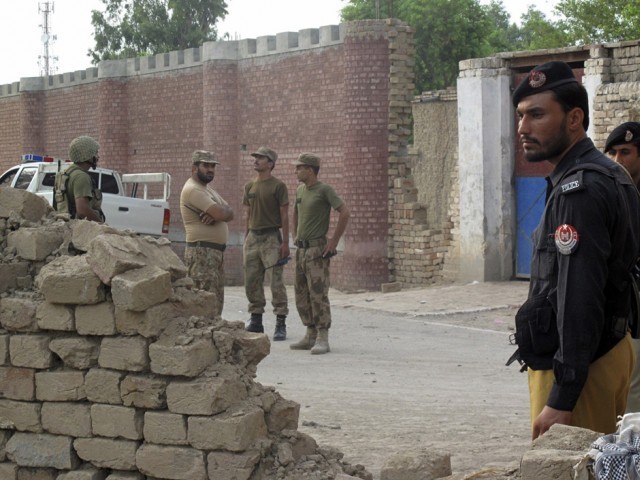Pakistani media hide the real motive of DI Khan Jailbreak – by Abid Sulehri
There is a silence on what happened on 29 July 2013 as the Taliban carried out brazen jail break. The silence is understandable considering the stakes involved in it. Pakistan Tehrik-e Insaf (PTI) cannot say much or protest for it rules Khyber-Pakhtunkhwa, and it was their administrative responsibility to protect the prison that held some of the violent and most wanted terrorists. PML-N government can easily evade responsibility for it insists that intelligence (prior information) was shared with provincial government about the imminent attack. Secret agencies can conveniently furnish evidence that both federal and provincial governments were given specific intelligence information about the Taliban attack. There is an unspoken agreement between all three to hush up the matter because accepting the responsibility will require their apology and obligatory resignation.
Media has stakes too. What else can explain their obsession with Presidential elections and drama in Supreme Court over contempt notice proceeding against Imran Khan. It serves well to talk about inconsequential political matters to hide the more ominous developments such as Parachinar massacre of Shias, and DIKhan jailbreak.
Silences such as stated above are a cover-up for the far worse and dangerous that happened in the prison. No media outlet has so far been willing to transmit the news concerning the Taliban’s bigger motive in launching the attack. According to news, coming in coaches and bikes, and breaking into the prison, the Deobandi Taliban militants kept chanting ‘Kaffir Kaffir Shia Kaffir’ (Shias are infidels) as they searched frenetically for Shia inmates. As they freed their fellow terrorists, each cell was searched with care to find a Shia, bring him out in the open and slaughter in front of more than 500 cheering Taliban militants.
Media is also silent about the ’30 most dangerous’ terrorists that the Taliban freed along with 243 others. All of them belonged to banned Deobandi sectarian group, Sipah-e Sahaba and Lashkar-e Jhangvi which currently operate as Ahl-e Sunnat Wal Jamaat (ASWJ). Among them were masterminds of Karachi Ashura massacre, and D.I. Khan Ashura attack that killed dozens of Shia mourners. Bannu jail break last year (2012) had set off debates about the efficiency of the law enforcement agencies and the government because all those who escaped were the Taliban. But D.I.Khan jail break has not sparked the same debate as such. It is quite understandable. All those released this time are sectarian militants of Lashkar-e Jhangvi Sipah-e Sahaba (LeJ-SSP, working as ASWJ now, under the leadership of Ahmed Ludhyanvi Deobandi, Malik Ishaq Deobandi and Aurangzeb Farooqi Deobandi) from whom Pakistanis in general do not feel much fear.
Simply put, the Deobandi Taliban are thought to be working against the state, while the Deobandi sectarian monsters (ASWJ, LeJ, SSP) specifically targets Shia community, in addition to a few attacks on Sunni Barelvis, Ahmadis and Christians, in Pakistan. Taliban target the citizens indiscriminately while Takfiri Deobandi terrorists of ASWJ-LeJ focus on dealing heavier blows to Shias, executing the Shia genocide with more ferocity and effectiveness. Thus the media can afford silence as long as the Sipah-e Sahaba Taliban’s focus is on Shia Muslims. Pakistani society as a whole is bending more and more towards Talibanization, while the ordinary Sunnis, Ahmadis, Chrisitans, Hindus and other minorities are desperately looking for safety along with the Shias who are facing genocide.
All this calls for Shias and other minorities to work for their self-defence. Pakistan is imploding, and the only way for state to delay this implosion is to turn the focus on Shia genocide alone. Thus in the days to come, we may see an increase in the attacks on Shias throughout Pakistan. And this genocide is unlikely to prompt the administration’s action.




Dawn’s editorial:
A DAY after the epic debacle that was Monday’s assault on Dera Ismail Khan’s Central Jail, KP Chief Minister Pervez Khattak said it was “very strange that people came in pickup trucks, motorbikes, broke into the jail and took away 250 prisoners easily”. Strange may be the correct term but it is equally applicable to the failure of his administration whose responsibility it is to ensure that such security breaches are prevented. This was no repeat of the Bannu jail raid last year. In this case, security and administration officials knew that such a hit was imminent. On Monday, hours before the attack, the area’s commissioner held a conference to discuss the matter with law-enforcement agencies and the civil administration. For the provincial administration to say, then, that it was an intelligence failure was both disingenuous and an irresponsible effort to deflect culpability. It was a tactical failure, pure and simple.
Why this tactical failure occurred, though, is extraordinarily disturbing in its implications. After the jail-break information was shared, standard operating procedures were fleshed out and specific response tasks were worked out. Over 100 jail guards and 75 personnel of the Frontier Reserve Force were available, as well as the Elite Police Force and armoured personnel carriers. But when it came to holding the line, the defences melted away. As a disgruntled security official said, metaphorically, the gun was there but there was no one to pull the trigger. Do law-enforcement personnel even have the capability of facing hordes as organised, single-minded and well-armed as the various militant groups clumped under the TTP? True, money has been pumped into the police force, particularly in KP, but most of it has gone towards salaries and increased strength. There has been little consideration of the fact that the numbers of personnel are immaterial if they aren’t trained for a fight that makes very specific demands.
If we are not to reach a situation where militant groups can set their sights on ever higher targets, the law-enforcement apparatus needs an immediate overhaul to meet the escalating challenges posed by what has been the reality for several years now. Pakistan needs to set up modern maximum-security prisons designed to resist assault and prevent escapes; colonial-era internment centres, relics of another age, are simply not enough. The equation is, on paper, simple: the militants are increasingly well-organised, trained and armed; the state law-enforcement apparatus is not. The outcome of the conflict will ultimately be decided on the basis of the disparity between the two sides’ capabilities.
http://dawn.com/news/1033364/poor-ability-to-fight-di-khan-jail-attack
I believe that it was not the incapability of the law enforcing personnel, they simply didn’t want to defend. The prior information was not used to heighten the security arrangements, the information was used to signal them not to resist. As per the reports, the jail personnel did not resist let alone retaliate. The terrorists had full information about the jail personnel, friends and foes. They blew up the foes and friends did not make it hard for them. Most of the jail staff did not pull trigger even once. The attack is a proof that the KP govt is inexperienced and incapable, an easy target in the hands of culprits who are exploiting the situation and making most from the circumstances. If any such intelligence was on cards, was it not shared with the CM and interior ministry machinery of the province? If it were, why didn’t they made sure increased security arrangements. In the center, can we forget the allegations on PMLN about having agreements with these banned outfits. Is this a continuation of that policy, “you flourish and we rule”.
Major thanks for the article.Really looking forward to read more.
I’m not sure I can out-comment anyone else on this article, but I do it’s good. I think your style of writing gives readers a reason to think and rethink.